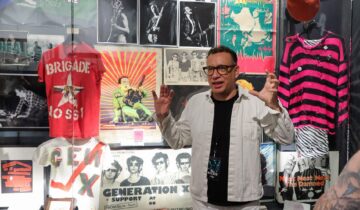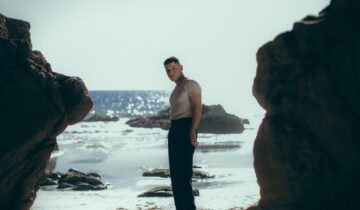 For THE ECONOMIST: “RICK WAS HERE” (2014), a short documentary film, explored the beginnings of Rick Rubin’s career. It was in a university dorm room in Greenwich Village, New York, in 1984 that he established Def Jam Records, a hip-hop record label. Radio stations at the time were mostly playing overproduced New Wave pop, but Def Jam made music that was raw and urgent, drawing on Mr Rubin’s experience in punk bands. Rap music soon went mainstream—it was Mr Rubin’s idea for Run-DMC and Aerosmith to collaborate on “Walk This Way”, the first rap track to make the top five of the Billboard Hot 100 chart—with Def Jam stars such as the Beastie Boys, Public Enemy and LL Cool J at the forefront. Since leaving the label, Mr Rubin has worked with artists such as Johnny Cash, the Red Hot Chili Peppers, the Dixie Chicks, Tom Petty, Mick Jagger, Justin Timberlake, Lady Gaga and Adele. He has won eight Grammy awards, and has been nominated a further 18 times.
For THE ECONOMIST: “RICK WAS HERE” (2014), a short documentary film, explored the beginnings of Rick Rubin’s career. It was in a university dorm room in Greenwich Village, New York, in 1984 that he established Def Jam Records, a hip-hop record label. Radio stations at the time were mostly playing overproduced New Wave pop, but Def Jam made music that was raw and urgent, drawing on Mr Rubin’s experience in punk bands. Rap music soon went mainstream—it was Mr Rubin’s idea for Run-DMC and Aerosmith to collaborate on “Walk This Way”, the first rap track to make the top five of the Billboard Hot 100 chart—with Def Jam stars such as the Beastie Boys, Public Enemy and LL Cool J at the forefront. Since leaving the label, Mr Rubin has worked with artists such as Johnny Cash, the Red Hot Chili Peppers, the Dixie Chicks, Tom Petty, Mick Jagger, Justin Timberlake, Lady Gaga and Adele. He has won eight Grammy awards, and has been nominated a further 18 times.
Yet “Shangri-La”, a new four-part documentary series on Showtime, is not much interested in going over these achievements; named after his studio in Malibu, it focuses on his musical methodology instead. The studio is presented as a mystical haven for recording artists, a place where the sun is always shining, the ocean is close by and the atmosphere is relaxed. Mr Rubin presides over it all, a shoeless and heavily bearded figure always wearing a white T-shirt and black shorts.
As a producer, it is his job to manage recording sessions, assist with the composition of songs and guide musicians to a product they are happy with. Mr Rubin is known for preferring a stripped-back sound, without fussy string arrangements, distracting horns or backing vocals. He believes less is more, testifies David Lynch, a film-maker, friend and regular visitor to Shangri-La. Mr Rubin is shown listening to playbacks of songs while laying down, his eyes closed. “I have no skill set,” he says. “It’s only intuitive.”
Somehow, it works. When Daniel Caesar, a Canadian singer-songwriter, contemplates adding a key change to one track, Mr Rubin suggests that they keep the key as it is but have the bass play something less rhythmic and more melodic. Mr Caesar is appeased. When Francis Farewell Starlite, the founder and lead singer of Francis and the Lights, tells Mr Rubin that he is singing at the top of his vocal range, Mr Rubin asks him to try a falsetto. It clearly sounds less strained. When Madison Ryann Ward, a pop singer, is unsure about her vocals, Mr Rubin tells her to “feel it, don’t think it”. Her next take becomes her favourite of the day.
Mr Rubin acts as a mentor and life coach to artists, too. He soothes and reassures Ezra Koenig, the lead vocalist and guitarist of Vampire Weekend, when he struggles to complete the band’s most recent album as he worries that it will sound like “Smash Mouth songs from a ‘Shrek’ movie”. He guides Sza, a singer and rapper, through a session of transcendental meditation to help her clear her mind of distractions. (“TM”, as he calls it, is one of his fixations; curiously, so is professional wrestling.) He tells Makkonnen, a rapper, to ignore previous slights, encouraging him to work on a song that others have dissuaded Makkonnen from releasing.
While it is certainly true that Mr Rubin’s approach can reap rewards, the series ignores the criticisms that have been levelled at him in the past—particularly that he masters recordings too loudly and that he can sometimes be detached. Morgan Neville and Jeff Malmberg, the directors, seem to be more interested in revering Mr Rubin than interrogating his method. Though the viewer sees Mr Rubin at work, the documentary’s emphasis is on the effect of his presence on artists as they work through the trials, tribulations and joys of the music-making process. His particular creative vision remains elusive, but perhaps that is the point. “Music is a soundtrack to the unseen world,” Mr Rubin reflects, “a search for magic.”
“Shangri-La” is screening on Showtime now



